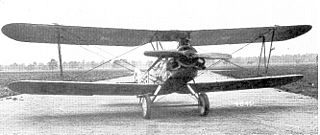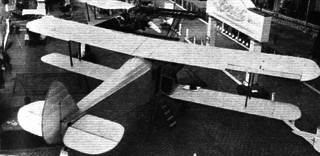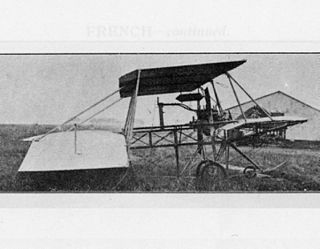Related Research Articles

The Bristol Scout was a single-seat rotary-engined biplane originally designed as a racing aircraft. Like similar fast, light aircraft of the period it was used by the RNAS and the RFC as a "scout", or fast reconnaissance type. It was one of the first single-seaters to be used as a fighter aircraft, although it was not possible to fit it with an effective forward-firing armament until the first British-designed gun synchronizers became available later in 1916, by which time the Scout was obsolescent. Single-seat fighters continued to be called "scouts" in British usage into the early 1920s.

The Bristol T.B.8, or Bristol-Coanda T.B.8 was an early British biplane built by the Bristol Aeroplane Company and designed by the Romanian Henri Coandă. Fifty four Bristol T.B.8s were built, being mainly used as a trainer. A small number of Bristol T.B.8s were briefly used as bombers at the start of the World War I by the Royal Naval Air Service.

The Bristol Taxiplane and Bristol Primary Trainer were British single-engine biplane light aircraft built by the Bristol Aeroplane Company in the early 1920s. A total of 28 were built, being mainly used as trainers.

The Bristol Gordon England biplanes were a series of early British military biplane aircraft designed by Eric Gordon England for the Bristol Aeroplane Company that first flew in 1912. Designed for easy ground transport, the aircraft could be quickly disassembled.
The Bristol Type 91 Brownie was a light sports aircraft produced in the United Kingdom by the Bristol Aeroplane Company in 1924. It was a low-wing cantilever monoplane aircraft of conventional configuration with fixed tailskid undercarriage. The pilot and passenger sat in tandem open cockpits. It won the £1,000 pound prize for second place at the Lympne light aircraft trials in October 1924.
The Avro 511 was designed as a fast scouting aircraft just before the First World War. Modified, it became the Avro 514. Though it had innovative features, development did not continue after the start of hostilities.

The Bristol Type 72 Racer was a British racing monoplane designed by Wilfrid Thomas Reid and built by the Bristol Aeroplane Company at Filton, England.

The Bristol Seely was entered into an Air Ministry competition for safe civil aeroplanes held in 1920. It was a single-engine biplane with accommodation for one passenger. After the competition, the single Seely was used as a testbed for the Bristol Jupiter engine development programme.
The Bristol Type 92, sometimes known as the Laboratory biplane, was an aircraft built by the Bristol Aeroplane Company to address the differences between wind tunnel cowling models and full scale cowling for radial engines and was designed as a scaled-up version of a wind tunnel model aircraft. One was built and flew in the mid-1920s.

The Bristol Type 110A was a single-engine biplane for charter work, accommodating four passengers in comfort. Designed by Frank Barnwell and built at Filton Aerodrome by the Bristol Aeroplane Company. No orders were obtained and only one aircraft was built.
The Royal Aircraft Factory S.E.4a was an experimental British single-engined scout aircraft of the First World War. Four S.E.4a aircraft were built, being used for research purposes and as home-defence fighters by the Royal Flying Corps. In spite of its type number it had little or no relationship to the earlier S.E.4
The Royal Aircraft Factory S.E.4 was a single-engined, single seat biplane designed and built at the Royal Aircraft Factory just prior to the start of the First World War. Intended to be as fast as possible, it recorded a speed of 135 mph (217 km/h), which made it the fastest aircraft in the world in 1914, but no production followed and it was soon written off in a crash.
The Short S.45 — also known as the Short T.5 after its naval serial number — was a training biplane built for Britain's Royal Navy by Short Brothers in 1912. It was the forerunner of another three identical aircraft delivered to the Royal Navy and Royal Flying Corps during 1912 and 1913. The Royal Naval Air Service was still operating the type when World War I broke out in 1914.

The Dunne D.8 of 1912 was a tailless swept wing biplane, designed by J. W. Dunne to have inherent stability. One example was supplied to RAE Farnborough. License-built Burgess-Dunne models were used by the US Signal Corps and United States Navy and the short-lived Canadian Aviation Corps. It was the latter's first and only warplane.

The Dyott monoplane was a single-engined, single-seat mid-wing monoplane designed by George Miller Dyott for his own use as a sports and touring aircraft. It proved successful, making a six-month tour of the United States soon after its first flight in 1913.
The Junkers T 23 was a two-seat, single-engined experimental training aircraft, built in Germany in the early 1920s. It could be configured either as a parasol winged monoplane or as a biplane to compare handling characteristics. 4 were constructed.

The ASL Viking was a single-engined two seater biplane aircraft designed and built by Horatio Barber's Aeronautical Syndicate Ltd. at Hendon. It was first flown in January 1912.
The Bristol Glider was an early British two-seat biplane glider designed in 1910s by George Challenger and built by the British & Colonial Aeroplane Company at Filton Aerodrome, Bristol.
The Bristol Racing Biplane was a British single-seat biplane designed to combine the performance of a monoplane but using the strength of the biplane. It was designed by Robert Grandseigne and Léon Versepuy, who were supervised by George Challenger for the British & Colonial Aeroplane Company of Bristol, it crashed on its first flight.

The Dunne-Huntington triplane, sometimes referred to as a biplane, was a pioneer aircraft designed by J. W. Dunne and built by A. K. Huntington. It was of unusual staggered triple-tandem configuration and an early example of an inherently stable aeroplane.
References
- Barnes, C.H. (1964). Bristol Aircraft since 1910 (1st ed.). London: Putnam & Company Ltd. pp. 93, 100.
- Bruce, J.M. (February 1979). "The First British Armoured Brigade: Part One". Air International . Vol. 16 no. 2. pp. 96–101.